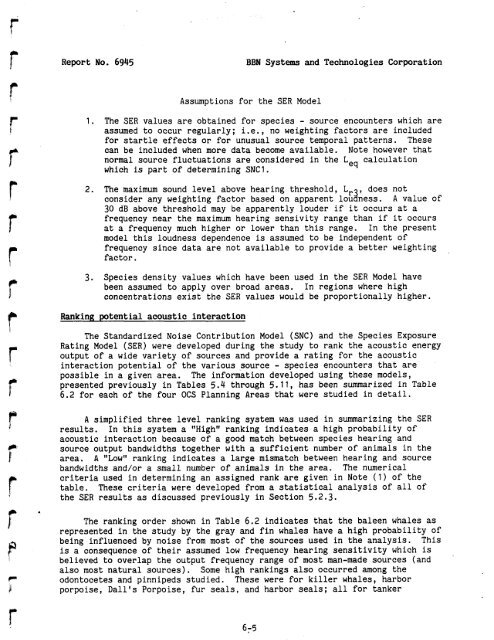Analysis and Ranking of the Acoustic Disturbance Potential of ...
Analysis and Ranking of the Acoustic Disturbance Potential of ...
Analysis and Ranking of the Acoustic Disturbance Potential of ...
Create successful ePaper yourself
Turn your PDF publications into a flip-book with our unique Google optimized e-Paper software.
Report No. 6945<br />
BBN Systems <strong>and</strong> Technologies Corporation<br />
Assumptions for <strong>the</strong> SER Model<br />
1. The SER values are obtained for species - source encounters which are<br />
assumed to occur regularly; i.e., no weighting factors are included<br />
for startle effects or for unusual source temporal patterns. These<br />
can be included when more data become available. Note however that<br />
normal source fluctuations are considered in <strong>the</strong> L calculation<br />
which is part <strong>of</strong> determining SNC1.<br />
eq<br />
2. The maximum sound level above hearing threshold,<br />
consider any weighting factor based on apparent lou Lri, ness. A value <strong>of</strong><br />
30 dB above threshold may be apparently louder if it occurs at a<br />
frequency near <strong>the</strong> maximum hearing sensivity range than if it occurs<br />
at a frequency much higher or lower than this range. In <strong>the</strong> present<br />
model this loudness dependence is assumed to be independent <strong>of</strong><br />
frequency since data are not available to provide a better weighting<br />
factor.<br />
3. Species density values which have been used in <strong>the</strong> SER Model have<br />
been assumed to apply over broad areas. In regions where high<br />
concentrations exist <strong>the</strong> SER values would be proportionally higher.<br />
<strong>Ranking</strong> potential acoustic interaction<br />
The St<strong>and</strong>ardized Noise Contribution Model (SNC) <strong>and</strong> <strong>the</strong> Species Exposure<br />
Rating Model (SER) were developed during <strong>the</strong> study to rank <strong>the</strong> acoustic energy<br />
output <strong>of</strong> a wide variety <strong>of</strong> sources <strong>and</strong> provide a rating for <strong>the</strong> acoustic<br />
interaction potential <strong>of</strong> <strong>the</strong> various ,source - species encounters that are<br />
possible in a given area. The information developed using <strong>the</strong>se models,<br />
presented previously in Tables 5.4 through 5.11, has been summarized in Table<br />
6.2 for each <strong>of</strong> <strong>the</strong> four OCS Planning Areas that were studied in detail.<br />
A simplified three level ranking system was used in summarizing <strong>the</strong> SER<br />
results. In this system a "High" ranking indicates a high probability <strong>of</strong><br />
acoustic interaction because <strong>of</strong> a good match between species hearing <strong>and</strong><br />
source output b<strong>and</strong>widths toge<strong>the</strong>r with a sufficient number <strong>of</strong> animals in <strong>the</strong><br />
area. A "Low" ranking indicates a large mismatch between hearing <strong>and</strong> source<br />
b<strong>and</strong>widths <strong>and</strong>/or a small number <strong>of</strong> animals in <strong>the</strong> area. The numerical<br />
criteria used in determining an assigned rank are given in Note (1) <strong>of</strong> <strong>the</strong><br />
table. These criteria were developed from a statistical analysis <strong>of</strong> all <strong>of</strong><br />
<strong>the</strong> SER results as discussed previously in Section 5.2.3.<br />
The ranking order shown in Table 6.2 indicates that <strong>the</strong> baleen whales as<br />
represented in <strong>the</strong> study by <strong>the</strong> gray <strong>and</strong> fin whales have a high probability <strong>of</strong><br />
being influenced by noise from most <strong>of</strong> <strong>the</strong> sources used in <strong>the</strong> analysis. This<br />
is a consequence <strong>of</strong> <strong>the</strong>ir assumed low frequency hearing sensitivity which is<br />
believed to overlap <strong>the</strong> output frequency range <strong>of</strong> most man-made sources (<strong>and</strong><br />
also most natural sources). Some high rankings also occurred among <strong>the</strong><br />
odontocetes <strong>and</strong> pinnipeds studied. These were for killer whales, harbor<br />
porpoise, Dall's Porpoise, fur seals, <strong>and</strong> harbor seals; all for tanker
















